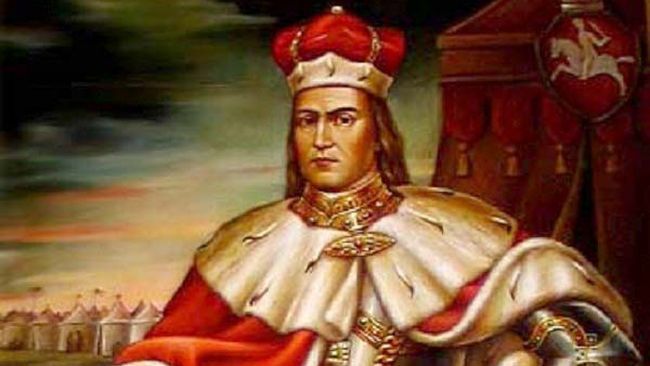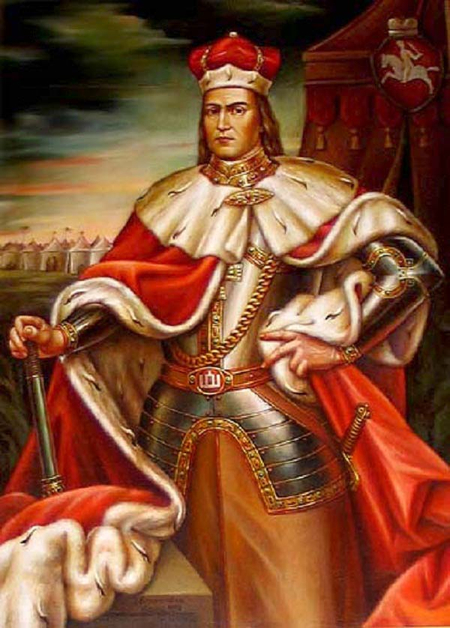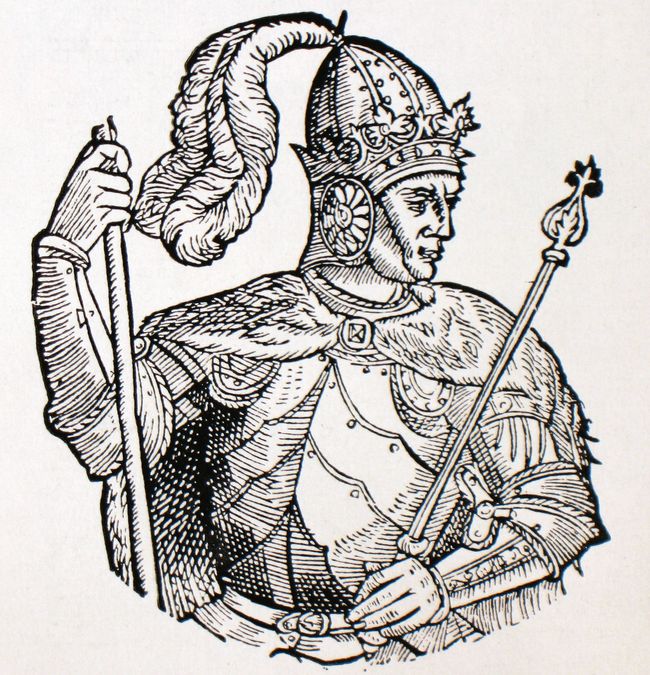Geopolitics: with sword in hand and diplomacy in mind
Grand Duchy of Lithuania under Vytautas the Great
This noted statesman ranked with Europe’s most influential rulers at the turn of the 15th century. Other powerful monarchs had to take his opinion into consideration, and the Grand Duchy of Lithuania he ruled in 1392-1430 was comparable in size and strength to the other great power of Eastern Europe, Kyivan Rus’, our ancient Ukrainian empire. Grand Duke Vytautas (c. 1350-1430) became what a modern analyst might call a “store brand” in the controversial and exceptionally interesting history of the Lithuanian, Ukrainian, and Belarusian peoples at the time (by the way, his duchy included territories subsequently annexed by Muscovy as Smolensk, Ryazan, Tula, and other regions/oblasts).
There are many interesting aspects to Vytautas’ life story. A nephew of Grand Duke Algirdas (b. 1296, d.1377; ruled as grand duke in 1345-77), he had to take part in wars since his youth (he was 20 when he took part in the Battle of Rudau [between the Grand Duchy of Lithuania and the Teutonic Knights on 17 or 18 February, 1370, near Rudau, a village north of Konigsberg (now Melnikovo village in Kaliningrad oblast, Russia). – Ed.] and that would be largely his lifestyle until his death at 80 years of age, a unique life span at the time. Another remarkable fact is that Vytautas was de facto commander-in-chief of the joint Polish-Ukrainian-Lithuanian-Belarusian army in the Battle of Grunwald (July 15, 1410) and played the key role in the spectacular victory over the formidable Teutonic Knights. That victory allowed to protect the independence of the Eastern European states. In a word, Vytautas left a significant mark in European history.
Of no smaller interest is the degree of influence Vytautas exerted on the grand duchy’s political, ideological, and particularly civilizational development. As a farsighted politician, he was keenly aware of the serious differences between, first, the Eastern Orthodox Ukrainians (or Rusyns/Ruthenians) and Muscovite boyars; second, the powerful Catholic world, namely the Rzeczpospolita Kingdom of Poland that was slowly but surely moving to engulf Vytautas’ empire, and third, there were the ethnic Lithuanians and Belarusians who were not totally sure about their religious and political affiliation. All this posed a threat to his realm. Not coincidentally, Vytautas was baptized three times: in 1382, as a Catholic, receiving the name of Wigand; two years later as an Eastern Orthodox adherent, Christened Alexander. This is a very significant fact. His multiconfessional (although predominantly Eastern Orthodox) realm stretched from Wilno (Vilna/Vilnius) to the River Oka (his army units often chased Tatar troops as far as the River Volga) and from the Black Sea to the River Don, including all Lithuanian, Belarusian, and most Ukrainian lands (without Halychyna but with Lutsk in the Volyn region, Kyiv, Podillia, Chernihiv, and Novhorod-Siversky). The ruler of such a big and diversified empire had to learn to maintain the inner equilibrium, if need be even maneuver between the opposing camps. Grand Duke Vytautas knew this only too well. To assume that the medieval rulers knew only how to fight, wield the sword would be a gross understatement. They also knew political strategy.
Getting back to Vytautas, it seems worth analyzing, even if briefly, the internal structure of the Grand Duchy of Lithuania. For the Ukrainians, primarily the populace of Naddniprianshchyna (Dnieper Ukraine), the period of Lithuanian rule (since Grand Duke Algirdas who conquered Kyiv in 1362) was better than the Golden Horde. Also, the Lithuanians, for want of manpower to run the vast territories the grand duchy had annexed, allowed the local Ukrainian nobility to occupy the highest administrative posts (Ukrainians constituted a large part of the population at the time). This policy helped the ethnic nobility join the victor’s numbers. Also, unlike Tatars, Lithuanians were not regarded by the populace as total strangers. The Lithuanian political leadership, starting with Grand Duke Gediminas (he ruled from 1315[16?] until 1341), was constantly under the cultural influence of its Slavic subjects. Many dukes of the Gediminas dynasty converted to Christianity, with an increasing number adopting the Eastern Orthodox rite. Rusyn/Ruthenian (actually Old Ukrainian) was spoken by most of the populace and eventually became the grand duchy’s official language. Lithuanians showed respect for the local ways and stressed that they were not going to change any old ways nor impose any new ones.

Photo from the website WIKIMEDIA.ORG
As a matter of fact, Gediminas, Algirdas, and especially Vytautas found themselves adjusted to the folkways in Ukraine and Belarus, so much so they resembled Kyivan Rus’ princes – the Ruriks – two or three generations later. To them (probably especially to Vytautas) all territorial gains were part of the process of gathering the lands of Rus’. They adhered to this cause decades before it was borrowed by Muscovy that would become the grand duchy’s main rival in the struggle for the Kyivan Rus’ heritage. Our number-one historian Mykhailo Hrushevsky may have had this in mind when he wrote that the Grand Duchy of Lithuania preserved the Kyivan Rus’ traditions to a greater degree than Muscovy. It is increasingly clear that the grand duchy was a state of Rus’ restored rather than a foreign one that absorbed Ukraine.
Vytautas had to travel a winding and thorny road to power. He had to agree to painful compromises with the Kingdom of Poland that had grown considerably stronger under Casimir III the Great (he ruled from 1333 until 1370) and was still a formidable power under Wladyslaw II Jagiello (Jogaila) after the Union (Act) of Krewo (Kreva) in 1385. Jogaila didn’t even bother to conceal his pressure on Vytautas. Where and whenever possible he wanted the grand duke to take orders from him. Vytautas’ reaction could well be expected, knowing his character. He remembered that Jogaila had secretly ordered his father Kestutis strangled in the Kreva Castle (August 1382) after luring him into the trap, presumably for talks, then arresting him. Vytautas had no choice and held long talks with his father’s murderer, now king of Poland, haggling over the terms and conditions of cooperation between the grand duchy and Rzeczpospolita, and how Wladyslaw II Jagiello would finally and formally recognize Vytautas as grand duke. The ceremony took place in 1392 when Vytautas was in his forties.
Vytautas tried to sever ties with Rzeczpospolita several times after the Union of Krewo, when Jogaila had married the reigning Queen of Poland Jadwiga, and take the throne (he had the status, but on this further on). Doubtlessly, under Grand Duke Vytautas Lithuania remained completely independent (but for losing the Battle of the Vorskla River to the Tatars in 1399, the grand duchy’s territory and might would have been much bigger and stronger). On the other hand, the ruling elite was converting to Catholicism, starting with a small part of Vytautas’ inner circle, then slowly but surely gaining momentum. In 1413, under the Union (Pact) of Horodlo, Wladyslaw II Jagiello pledged to grant the Lithuanian Catholic boyars the same privileges as the Polish szlachta (nobility) had recently received. Shortly afterward, 47 Polish szlachta families offered as many Lithuanian noble families to borrow their coats of arms. Of course, there was the other side of this ideological and political coin: the Polish-Lithuanian nobility rapprochement broadened the gap between the Lithuanian and Ukrainian nobility, with far-reaching consequences.
The Grand Duchy of Lithuania under Vytautas the Great – like Kyivan Rus’ in time of decline – was made up of semi-independent duchies ruled by members of the Gediminas dynasty. There was also a difference that became especially apparent during Vytautas’ rule and eventually allowed Lithuania to avoid the feudal division suffered by Kyivan Rus’. The Lithuanian grand dukes were unequivocally the political rulers, not just the first among the equals within the dynasty (here a parallel can be drawn between Grand Duke Vytautas and Prince Yaroslav the Wise). Vytautas was worried about a number of Gediminas dukes getting Ukrainized, putting down roots in their lands and taking local interests to heart more than they did those of the grand duchy. He was afraid this could give rise to separatist moods.
In an effort to rectify the situation, Vytautas constantly had dukes/princes transferred from one domain to the next, depriving them of local support. For example, Theodore Liubartas, Prince of Lutsk, started losing estates until he found himself stripped of his rich Volyn (Vohlynia) lands. In exchange, he was offered the poorer and remote principality of Novhorod-Siversky. Naturally, he didn’t want it but eventually had to accept it.

Photo from the website WIKIMEDIA.ORG
If a prince refused to toe the line (as was the case with Prince Theodoras Karijotaitis – or Fedir Koriatovych – of Podillia, the grand duke would accuse him of contumacy, send an army and force him into exile. Vytautas would replace such semi-independent princes with his officers (voivodes), often from among untitled boyars who came in possession of lands “by the grace of the Grand Duke.” It was thus the Ukrainian nobility felt the “advantages” of centralized governance, something they had never experienced. Naturally, they didn’t like it and showed their chagrin.
Vytautas conducted a very active foreign policy. Here is only one interesting fact. The rebellious followers of the legendary Czech priest, philosopher, and martyr John Huss proclaimed the grand duke “King of Hussites” as a recognition of his political, material, and moral support. Doubtlessly he reached the peak of his diplomatic career when he took an active part in the famous royal Congress of Lutsk (January 1429). The capital city of Volyn was then literally the center of European politics and diplomacy. Among those present were future Holy Roman Emperor Sigismund of Luxemburg and his wife Barbara; Wladyslaw II Jagiello of Poland; Pope Martin V’s legate Andrew Dominican; princes of Ryazan, Novgorod, Pskov, those of the Odoevsky family (all then independent, tending to join the Lithuanian empire, eventually to be overpowered by Muscovy); Vasily II of Russia with his knyaz princes; prince of Tver; Komtur of Balga of the Teutonic Knights; Moldovan delegates; khans of Volga, Don, and Perekop; Eric of Pomerania of the Danish Kingdom; Master Siegfried Landorf Spanheim and his knights of the Livonian Order; delegates of Byzantine Emperor John VIII Palaiologos, and Metropolitan Photius of Kyiv. The agenda (first and foremost, the coronation of Vytautas as King of Lithuania, also siege of Moldova, potential coalition against Turkey, better relations between Denmark and Hanseatic League, religious, economic, trade, and tax-related issues) demonstrated the increasing role the grand duchy was playing in European politics. King Sigismund’s overdue motion to coronate Vytautas was supported by Wladyslaw II Jagiello, but then the Polish szlachta pressured the king into recanting. Coronation preparations continued nevertheless.
The ceremony was scheduled for September 1430, to coincide with the Nativity of the Virgin Mary, but Polish magnates stopped Holy Roman Emperor Sigismund’s delegates with the crowns for Vytautas and his wife Uliana Olshanska, made in Nuremberg, and the event never took place. According to certain historical sources, Wladyslaw II Jagiello proposed a compromise in Wilno, in October, that allowed the coronation provided one of Jagiello’s sons receives the Lithuanian crown after Vytautas’ passing. The grand duke’s last letters show that he could agree, but his desire to be coronated and thus raise his own and his empire’s ratings, to secure the grand duchy’s sovereignty never came true. The 80-year-old monarch was suddenly taken ill and died on October 27, 1430, in the Trakai Island Castle (currently in Lithuania), although the burial site remains to be established. Most likely, the Lithuanian crown was seized by Polish magnates.
***
The name and achievements of Vytautas/Vitovt the Great serve as graphic proof that the Ukrainian and Lithuanian peoples actually have a common history. The 16th-century Polish cartographer, diplomat, and historian Marcin Kromer wrote that, although there were no lifetime portraits of the grand duke (all were created several decades after his death), his name would never be forgotten. An anonymous contemporary of Vytautas, author of the “Word of Praise” addressing the monarch of Wilno, wrote that “Grand Duke Vytautas was a powerful ruler, glorified in all lands, with kings and princes attending his court.” According to Sigismund von Herberstein (1486-1566), a Carniolan diplomat, writer, historian, and member of the Holy Roman Empire’s Imperial Council (most noted for his extensive writing on the geography, history, and customs of Russia), Vytautas was “the best personality Lithuania has ever known.” As time passed, this assessment proved increasingly convincing until it became an axiom.
Section
Society





